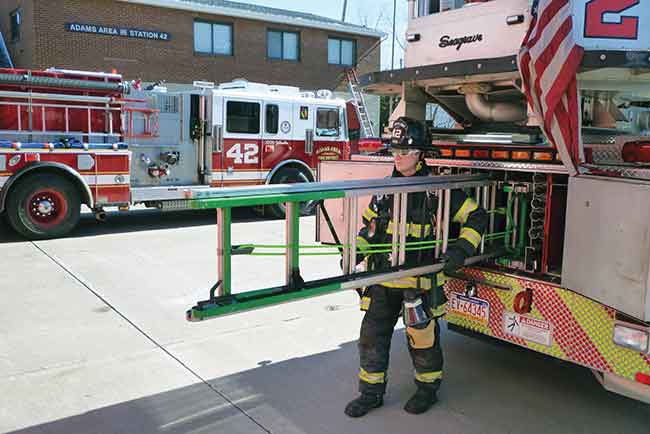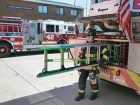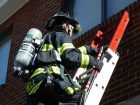
Tim-bits – April 2016
Tim Llewellyn
Features Equipment Hot TopicsThe following situation is probably familiar: it was a good structure fire; all of the teams performed as expected; few mistakes were made overall; a lot of property was saved; and, most importantly, nobody was hurt. Now, it’s time to clean up. Two firefighters are assigned to walk around and through the scene one last time to check for any equipment that might have been left behind.
 Green markings on the ladders and bright green halyards indicate that the equipment belong to the tower ladder truck. Tim Llewellyn shares his department’s process of marking tools and ladders in order to keep track of them. The process
Green markings on the ladders and bright green halyards indicate that the equipment belong to the tower ladder truck. Tim Llewellyn shares his department’s process of marking tools and ladders in order to keep track of them. The processWhen the firefighters complete their search, several axes, Halligan bars, pike poles and hooks lay on the ground waiting for their proper owners to claim them. A group of firefighters assembles and begins the sorting process. The firefighters closely examine each tool, looking for the little stickers or other markings or engravings that identify them as belonging to a specific truck. Another group of firefighters is examining the ladders – trying to determine which ladders go with which trucks. This frustrating sorting process occurs all too often, but it doesn’t have to be so difficult.
There are ways to simplify tool accountability and recognition; implementing these practices can also increase fire-ground efficiency and create a sense of pride for the members of your organization.
Most fire departments put small, rectangular, metallic stickers printed with the organization’s name to identify their tools. These stickers are great – they stick well and last a long time – but the printing does wear off over time and the small size makes the stickers difficult to see from a distance.
One very easy and inexpensive way that our department marks our hand tools is by colouring a section of the tools with spray paint. The first step is to select a colour that will be applied to each of your trucks’ tools. We chose basic colours: the tools on E1 are red, E2’s tools are orange, E3’s are yellow, the rescue’s are blue, the tower ladder’s are green and tools from the chief vehicles are white. We place colour stripes on the shaft of each tool in a band about four-inches wide; this provides enough visibility so that the tools can be identified from a distance and avoids the action surfaces of the tools, which are prone to heavy abrasion. We prefer enamel spray paint because it can be easily touched up or redone after incidents or trainings.
We do the same with our ladders; the coloured markings go on the tips according to the assigned colour of the truck’s tools. The addition of colour not only identifies the ladders as belonging to particular trucks, but the contrast of the colour on the tip also increases visibility in low-light situations. With better visibility, crews are more easily able to place ladders correctly to windowsills or above roof edges. One of our captains even went so far as to replace the halyards on each of the extension ladders with 9.5-millimetre (3/8-inch) life safety rope in each respective colour. Our firefighters have commented that the coloured halyards not only look good, but also provide for an easier and firmer grasp when extending and retracting the ladders, especially in wet conditions, when compared to the manufacturer-standard nylon or manila halyards.
Another good idea from our team is to use a stencil and the same paint colour to mark the apparatus number on the balance point of each one- and two-section ladders. These markings further identify where the ladders came from, and help firefighters find the balance point on the ladder beam for a single-firefighter carry and raise.
Our department’s process of marking tools and ladders has turned out to be a source of great pride for members. We regularly hold tool-cleaning days that have resulted in a significant improvement in morale and esprit de corps for our organization. During the tool cleaning process, members strip the old paint and rust off of the tools with a wire wheel and give them new, fresh markings. The ladders are scrubbed and touched up as needed. The edges of the axes and Halligan bars are honed and rubbed with a light coating of tool oil. These simple activities bring everyone together to work toward a source of pride – clean tools.
If you’ve found yourself trying to figure out which tools are yours after a fire, consider using this simple colour-coding method for identification; it makes recognition a snap. Markings also make it easier for firefighters to spot which company’s ladders were thrown when the fire makes the evening news!
Tim Llewellyn is a firefighter for the Allegheny County Airport Authority in Pittsburgh, Pa., and an instructor for a number of fire academies and training faculties. llewellyn.fire@gmail.com
Print this page

